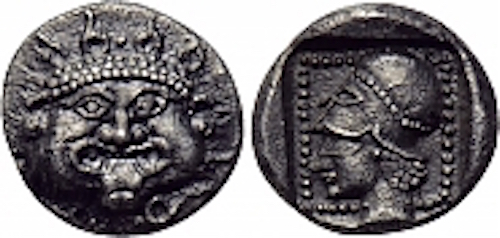(Coins from Methymna; photo: internet)
There was a time when the small town of Molyvos – which used to be called Methymna – had its own king and even its own bishop. It was the second city of Lesvos and as a citystate it quarrelled for a long time with the other big town of the island: Mytilini. Regularly soldiers were sent back and forth and they even conquered other states; Arisva (now Kalloni) belonged for some time to Methymna.
During the Peloponnesian war (431 – 404 BC) Methymna choose to side with Athens, while the other Lesvorian citystates sided with Sparta. Did Methymna choose Athens for political reasons or was it being faithful to the Goddess Athena, who gave Athens its name and was much depicted on ancient coins and pottery as the Goddess of war?
Lesvos is not far away from the regions where the first Western coins were minted – the island of Aegina, where the oldest drachma, which depicts a land turtle, was found (about 700 BC), and Ephesus, then part of the kingdom of Lydia, the cradle where the first coins originated. The prosperous citystates of Mytilini and Methymna eventually followed and two centuries later minted their own coins.
In the fourth century BC the Gods of Olympus were still venerated in Greece and when Zeus was angry with Methymna he released heavy thunderstorms. To appease this God the villagers threw a virgin into the sea. Zeus might have had plenty of reason to be angry with Methymna. For a certain period this citystate was seen as a Sodom and Gomorrah, due to its plenitude of prostitutes who, like their clients, hit the bottle pretty hard and took their time to sleep off the booze. Around 442 – 443 BC the new king Kleomenis having had enough of this debauchery, arrested all the pimps, had them tied in sacks and thrown into the sea – a clear sign for the whores to quit their jobs.
In those times you would find land turtles depicted on the coins of Methymna. This animal was seen as a symbol for fertility and was one of the favourites of Aphrodite, the Goddess of Love. The head of Silenus was regularly minted into the coins too. This bearded man was the drinking buddy of Dionysus, the God of the wine. He was known for his love for the nymphs and for the donkey he rode which would chase giants while braying. Other people thought Silenus was the teacher of Dionysus, and that he was a foolish but wise man and thus loved by Greek sages.
You could often also find a gorgon’s head on the coins, the head of a monstrous goddess with a nest of snakes as her hair. You might think that this head was a symbol for the sorry state of Methymna and its whores, but in fact it was the symbol of protection against the evil eye, a phenomenon still existing in today’s world.
Later the coins became more serious and depicted bunches of grapes or drinking cups. You could read this as yet more symbols for bad drinking, but in those times wine making had become very popular and by the time the Romans conquered Greece, Lesvos was reknowned for its good wine, and the one from Methymna was praised as the best.
The citystates eventually disappeared, quarrels were ended because mighty enemies had to be fought together. Lesvos was ruled by many foreign states and when in 1922 it became Greek again, it was divided into different municipalities. This lasted until today’s crisis hit the country and three years ago thousands of municipalities had to be assembled into bigger units and as such Lesvos became one big municipality.
The municipality of Lesvos has very little or no money: none to clean the island (that’s done by the inhabitants), none to repair roads (some of them impossible to use) and none to replace lamps in the lampposts (streets are becoming dark). Even so, many taxes are being paid, nobody knows what that money is used for nor where it is. The big municipality is in chaos.
Last year, when the tourist season started, lots of people believed the crazy stories that came through the grapevine, for instance, that no money would come out of ATM’s, that nothing would function and that the island (and the rest of Greece) was like a big battlefield with riots and tear-gas on every street corner. How stupid can people be.
Although I am talking about a chaotic municipality with broken lampposts, I don’t mean that the island is in darkness. There still is sufficient light on the streets and there still are plenty of people who do everything to keep life normal. For instance last Sunday children and the elder citizens of Molyvos cleaned the streets and beaches around the city.
The plan to install a customhouse in Petra for boats to come and go to Turkey from the north of the island has still not worked out. Is this due to a lack of money or is Mytilini afraid to loose this ever increasing number of tourists to Molyvos and Petra? The Turkish tourists arriving in Mytilini mainly come for just one or two days and a visit to the idyllic medieval town of Molyvos entails a pretty long bus journey, an incentive to remain in Mytilini, where the shops do great business.
If Methymna still had its own king and an army, I am sure that they would by now have attacked Mytilini, because it is said that they keep the municipality money and that they prevent the Turks from sailing straight to Molyvos. If new coins were to be minted, one side would again depict a helmeted Athena, ready for the battle and on the other side you could find a tourist bus – because Molyvos still boasts of its ancient Methymnesian fame and remains the most visited tourist place of the island.











